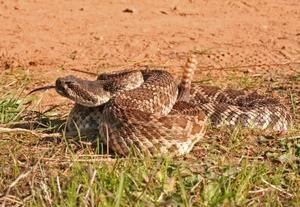Public healthRattlesnakes in San Diego: potent, powerful venom a cause for concern
For the second year in a row, University of California-San Diego Medical Center toxicologists are reporting unusually powerful snake bites and unusually extreme patient reactions to those bites; since January, several patients have suffered bites with severe symptoms, such as difficulty breathing, often after a bite from the Southern Pacific Rattlesnake

A Southern Pacific rattlesnake in San Diego // Source: myspace.com
For the second year in a row, University of California-San Diego Medical Center toxicologists are reporting unusually powerful snake bites and unusually extreme patient reactions to those bites. Since January, several patients have suffered bites with severe symptoms, such as difficulty breathing, often after a bite from the Southern Pacific Rattlesnake.
“Our victims are showing symptoms of severe weakness, trouble breathing and low blood pressure this year,” said Richard F. Clark, M.D., director of the division of medical toxicology at the University of California, San Diego and medical director for the California Poison Control System (CPCS), San Diego Division, UC San Diego Medical Center.
A University of California-San Diego release reports that symptoms can include: extreme pain at the location of the bite, nausea, and sometimes diarrhea, followed by swelling in the mouth and throat, making it difficult to breathe. Within minutes, the victim can get lightheaded, collapse and go into shock. With some rattlesnake bites, no venom is injected into the wound, but because it is impossible to know if venom has or has not been injected, getting medical treatment quickly is important.
Clark emphasized that while San Diego County is seeing a rise in snake bite cases each year, the more alarming factor recently is the toxicity of the bite. Toxin levels in rattler venom vary from year to year and season to season but, typically, venom is weaker in winter and stronger in summer because snakes are more active, fighting for food and for survival.
“We really don’t know why the venom is becoming increasingly potent. Some speculate that with the modern world encroaching on nature it could be survival of the fittest. Perhaps only the strongest survive,” said Clark. “UC San Diego will be conducting clinical trials later this summer with a new antivenom for rattlesnake bites.”
The majority of the injuries are on hands, fingers, and feet, and the most typical result is swelling and tissue damage that looks like blisters or frost bite.
“What exacerbates the problem is that most bite victims are bitten on their dominant hand,” Clark pointed out. “They’re reaching down a hole, perhaps trying to move the snake or handle the snake in some way, and they do that with their dominant hand. When a person’s hand or leg is bitten, any movement is extremely painful: swelling occurs and the patient can’t bend the fingers, sometimes for months after the incident. It can really affect daily life. The patient can’t sign a check, write a paper for school, or hold a coffee cup.”
What to Do?
Get to the emergency department or a nearby health care facility immediately if you are bitten by a snake. Administration of antivenom is the most important treatment. Traditional first aid treatments such as applying ice, using a tourniquet, or applying suction to the wound have little value and may cause more injury.
If the victim is in a remote area when bitten by a rattler, first immobilize the wounded area, especially for a hand or arm bite, then proceed slowly to a vehicle. Moving slowly will keep the heart rate low and help prevent the venom from spreading. If bitten on the leg or foot, it might be necessary to use that limb to get to the vehicle, unless someone can carry the victim. If walking is necessary, it is very important to move slowly. Drive to the nearest phone, call 911 and wait for assistance. If there is no phone nearby, proceed to the nearest hospital.
